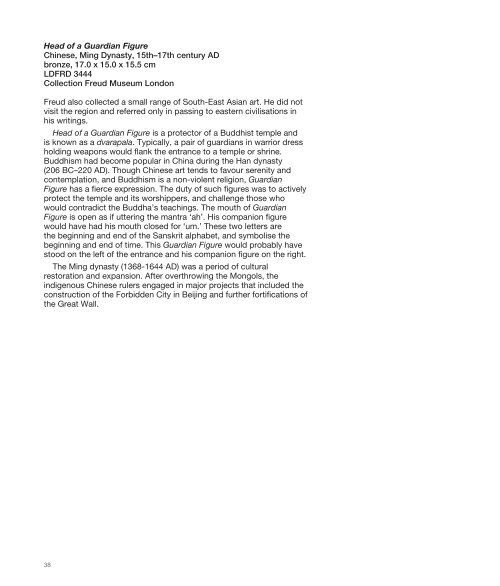sigmund freud's collection an archaeology of the mind
sigmund freud's collection an archaeology of the mind
sigmund freud's collection an archaeology of the mind
Create successful ePaper yourself
Turn your PDF publications into a flip-book with our unique Google optimized e-Paper software.
Head <strong>of</strong> a Guardi<strong>an</strong> Figure<br />
Chinese, Ming Dynasty, 15th–17th century AD<br />
bronze, 17.0 x 15.0 x 15.5 cm<br />
LDFRD 3444<br />
Collection Freud Museum London<br />
Freud also collected a small r<strong>an</strong>ge <strong>of</strong> South-East Asi<strong>an</strong> art. He did not<br />
visit <strong>the</strong> region <strong>an</strong>d referred only in passing to eastern civilisations in<br />
his writings.<br />
Head <strong>of</strong> a Guardi<strong>an</strong> Figure is a protector <strong>of</strong> a Buddhist temple <strong>an</strong>d<br />
is known as a dvarapala. Typically, a pair <strong>of</strong> guardi<strong>an</strong>s in warrior dress<br />
holding weapons would fl <strong>an</strong>k <strong>the</strong> entr<strong>an</strong>ce to a temple or shrine.<br />
Buddhism had become popular in China during <strong>the</strong> H<strong>an</strong> dynasty<br />
(206 BC–220 AD). Though Chinese art tends to favour serenity <strong>an</strong>d<br />
contemplation, <strong>an</strong>d Buddhism is a non-violent religion, Guardi<strong>an</strong><br />
Figure has a fi erce expression. The duty <strong>of</strong> such fi gures was to actively<br />
protect <strong>the</strong> temple <strong>an</strong>d its worshippers, <strong>an</strong>d challenge those who<br />
would contradict <strong>the</strong> Buddha’s teachings. The mouth <strong>of</strong> Guardi<strong>an</strong><br />
Figure is open as if uttering <strong>the</strong> m<strong>an</strong>tra ‘ah’. His comp<strong>an</strong>ion fi gure<br />
would have had his mouth closed for ‘um.’ These two letters are<br />
<strong>the</strong> beginning <strong>an</strong>d end <strong>of</strong> <strong>the</strong> S<strong>an</strong>skrit alphabet, <strong>an</strong>d symbolise <strong>the</strong><br />
beginning <strong>an</strong>d end <strong>of</strong> time. This Guardi<strong>an</strong> Figure would probably have<br />
stood on <strong>the</strong> left <strong>of</strong> <strong>the</strong> entr<strong>an</strong>ce <strong>an</strong>d his comp<strong>an</strong>ion fi gure on <strong>the</strong> right.<br />
The Ming dynasty (1368-1644 AD) was a period <strong>of</strong> cultural<br />
restoration <strong>an</strong>d exp<strong>an</strong>sion. After overthrowing <strong>the</strong> Mongols, <strong>the</strong><br />
indigenous Chinese rulers engaged in major projects that included <strong>the</strong><br />
construction <strong>of</strong> <strong>the</strong> Forbidden City in Beijing <strong>an</strong>d fur<strong>the</strong>r fortifi cations <strong>of</strong><br />
<strong>the</strong> Great Wall.<br />
38

















